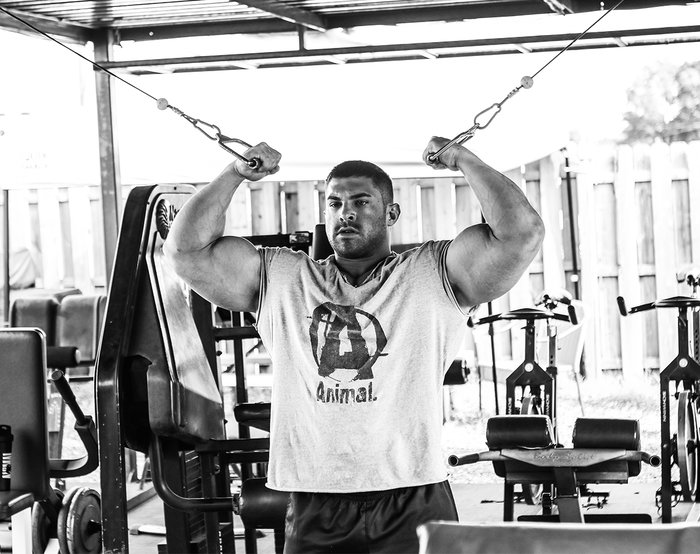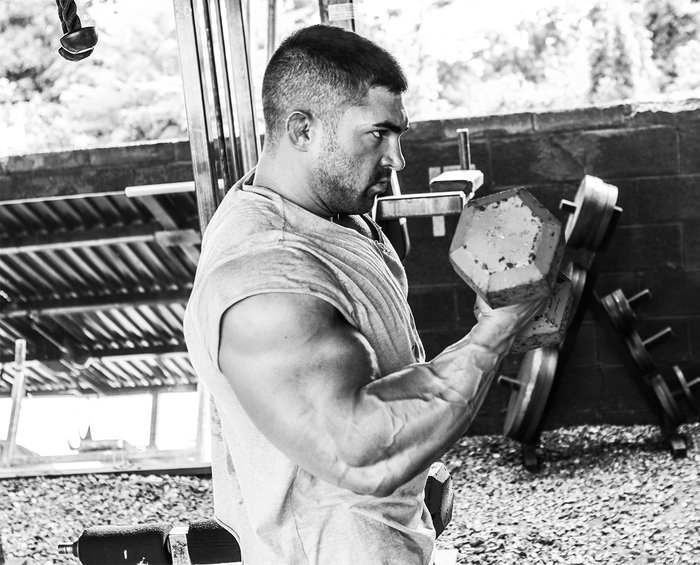When I was a young lifter, I looked to IFBB professional bodybuilders for guidance on training and diet. Every day, it seemed, I would go online and look for videos of lifters like Jay Cutler and Evan Centopani to help me stay motivated and learn the best exercises to train each muscle group.
At first, I would simply do exactly what I saw in the videos—the same exercises, the same number of reps and sets, and the same amount of time under tension. I'm sure you've probably been there! Over the years, though, I backed away just a little and began analyzing how these guys were training, as opposed to the simple X's and O's on the page. Then, I developed my own way of training based on the trends I saw from the most successful guys—combined with my own hard-earned experience, of course. I call this approach the 5 Pillars.
You can apply these pillars to every training, no matter which body part you're working on, but the examples I'm using are specific to arm training—you're welcome!
Pillar 1: The Isolation Warm-Up
The first pillar, warm up and isolate the proper muscle fibers, may be the most important pillar of all. When you first get to the gym, your body isn't usually ready for heavy lifting. Just a couple of sets of body part-specific isolation work not only prepares your muscles for what's to come, but also helps focus your mind on the workout ahead.

If you're young enough, you might be able to get away with starting cold, but why risk injuring yourself and setting your training back for weeks or months just because you didn't want to take the time to warm up? All it takes is one injury and you're on the sidelines. Start with lighter weight and get a solid pump before you start adding more volume.
The purpose of these lighter sets is to warm up the muscle, but they can also help you fatigue the targeted muscle—especially when you focus on proper form and on squeezing hard throughout the entire rep range. I typically do 2-4 sets of 15-20 reps per set for my warm-ups.
Prescription: 1 movement per body part, 2-4 sets of high reps, at least 15 reps per set
Sample movements for arms: High-pulley cable curl, rope triceps push-down
Pillar 2: Heavy Lifting
Once your target muscles are fired up, the next pillar of training comes into play: heavy lifting. This is the "meat and potatoes" of lifting and includes familiar compound exercises such as bench press, squat, deadlift, pull-ups, shoulder press, leg press, and all manner of row variations. In the case of arms, it can include isolation movements that also happen to be the heaviest movement you'll do during the workout, such as biceps curls or skullcrushers.
These exercises are great for building overall size and strength, but come with a much higher risk of injury. By warming up before you start these compound movements, you get a better feel for muscle contraction. This enables you to use less weight while getting the same or better result, and helps prevent injury. Read that sentence again.

Never sacrifice form for weight. That's the difference between the bodybuilder who keeps going for years, and the one who bounces from injury to injury. If the weight becomes too heavy to get 10 reps, or if your form begins to suffer, drop the weight back down and crush the last set or two.
You always want to push yourself, but it's OK to go back down in weight if it's too heavy. This is bodybuilding, not ego-building.
Prescription: 1-2 movements per body part, 3-4 sets, progressively increasing weight to drop rep range from 15-20 per set to 10-12 per set
Sample movements for arms: Barbell curl, EZ-bar curl, preacher curl, close-grip bench press, weighted push-ups, dips, all manner of skullcrushers
Pillar 3: Active Recovery and Time Under Tension
Following the heavy compound lifts, I move to the "active recovery" pillar. Your muscles just took a beating from the last few exercises and you should be feeling exhausted. Instead of getting sloppy in training, give your body a slight rest. But by "rest," I don't mean sitting around or using this time to talk your way out of finishing your workout.
Use a lighter weight so you can work through the entire range of motion, keeping the muscle under constant tension throughout each rep. Go light, and don't kill yourself. You've still got a lot of work to do!
Prescription: 1-2 movement per muscle group, 2-3 sets of 15-20 reps
Sample movements for arms: Cable curl, cable push-down, Incline close-grip bench with EZ-bar

Pillar 4: Supersets and Dropsets
The best time to push yourself the hardest is as you finish up a workout, and there's no better way to do that than with supersets and dropsets. You got a break of sorts during Pillar 3, so now you should be ready to pump your muscles full of blood and push as many reps as possible on each set. This is where you stop counting, and just keep working.

If you start to get sloppy here, reduce the weight or move on to another exercise. You should be absolutely exhausted after completing two or three of these kinds of sets. If you're doing contest prep, this is also where you push caloric burn through the roof.
Prescription: 2-4 movements per muscle group, 3-5 sets of high reps with multiple drops or supersets. Don't sweat the specifics; just chase the pump!
Sample movements for arms: All types of machines, hammer curl, alternating curl variations, cable movements
Pillar 5: Stretch
Now that you're exhausted, it's time to stretch the muscle fibers and start pushing blood and nutrients into them. This will help with recovery and muscle growth.
You can do this by performing isometric stretching, or by doing exercises that emphasize big stretches, such as stiff-leg deadlifts on leg day, or hanging from a bar on back day. Unlike isometrics, these exercises use weights or body weight to stretch the muscles past normal range.
Just be careful when you use weights to help you stretch. Go light, pay attention to form, and remember that the goal at this point is to stretch, not fatigue, your muscles.
The Systematic, Adaptable Way to Grow
The 5 Pillars approach provides a simple, structured approach to weight training that can work for both beginners and advanced lifters, while allowing you to incorporate all kinds of variety into your training. Done right, it'll help you prevent injury, do some solid heavy lifting, and get the most out of your training for years on end.

When you link these pillars together, you should feel some of the biggest pumps of your life, leave the gym exhausted, and enjoy the feeling of accomplishment that comes from knowing you gave everything you had. Now go do it!

